

Compact Muon Solenoid
LHC, CERN
| CMS-PAS-SMP-18-013 | ||
| Measurement of the associated production of a W boson and a charm quark at $\sqrt{s}= $ 8 TeV | ||
| CMS Collaboration | ||
| July 2019 | ||
| Abstract: A measurement of the associated production of a W boson and a charm quark is presented. The analysis uses a data sample corresponding to a total integrated luminosity of 19.7 fb$^{-1}$ collected by the CMS detector at the LHC at a centre-of-mass energy of 8 TeV. W bosons are identified through their leptonic decays to an electron or a muon and a neutrino. Charm jets are selected using semileptonic and other inclusive decays of charm hadrons. The cross section $\sigma({\rm pp} \rightarrow {\rm W + c + X}) {\cal B}({\rm W}\rightarrow \ell \nu)$ (where $\ell =$ e and $\mu$), and the cross section ratio $\sigma({\rm pp} \rightarrow {\rm W^+ + \bar{c} + X})/\sigma({\rm pp} \rightarrow {\rm W^- + c + X})$ are measured, both inclusively and differentially as a function of the absolute value of the pseudorapidity and the transverse momentum of the lepton from the W boson decay. The measurements are compared with theoretical predictions. | ||
|
Links:
CDS record (PDF) ;
inSPIRE record ;
CADI line (restricted) ;
These preliminary results are superseded in this paper, Submitted to EPJC. The superseded preliminary plots can be found here. |
||
| Figures | |

png pdf |
Figure 1:
Leading order diagrams for the associated production of a W boson and a charm quark. The electric charges of the W boson and the c quark have opposite sign. |
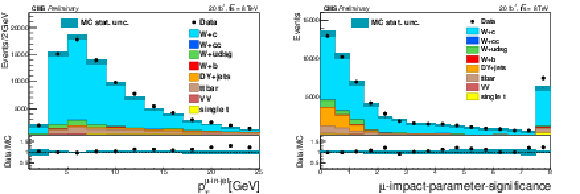
png pdf |
Figure 2:
Distributions of the $ {p_{\mathrm {T}}} $ (left) and IPS (right) of the muon inside the c-jet for events in the SL sample, adding the two W decay channels. The last bin in the IPS distribution includes all events with IPS > 7.5. The contributions of the various processes, after OS-SS subtraction, are estimated with the simulated samples. Vertical bars on data points represent the statistical uncertainty in the data. The hatched areas represent the statistical uncertainty in the MC simulation. The ratio data/MC is shown at the bottom. |
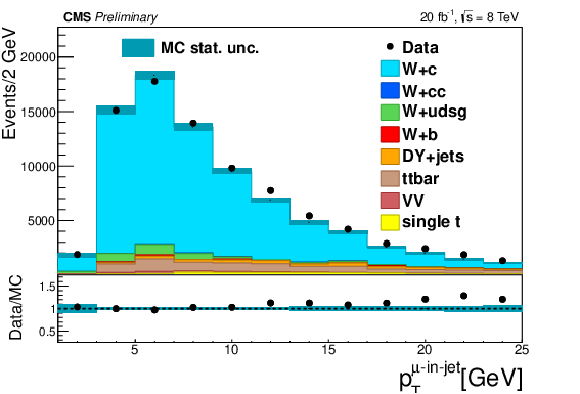
png pdf |
Figure 2-a:
Distribution of the $ {p_{\mathrm {T}}} $ of the muon inside the c-jet for events in the SL sample, adding the two W decay channels. The contributions of the various processes, after OS-SS subtraction, are estimated with the simulated samples. Vertical bars on data points represent the statistical uncertainty in the data. The hatched areas represent the statistical uncertainty in the MC simulation. The ratio data/MC is shown at the bottom. |
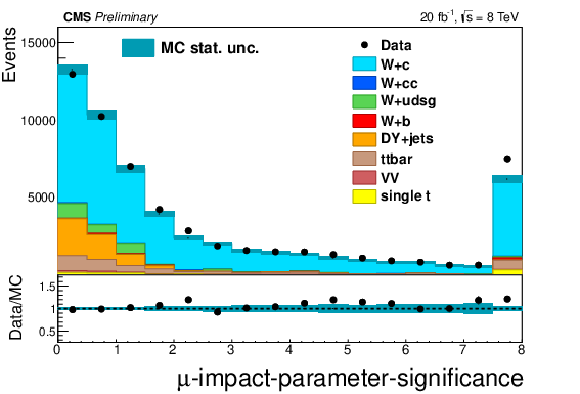
png pdf |
Figure 2-b:
Distribution of the IPS of the muon inside the c-jet for events in the SL sample, adding the two W decay channels. The last bin in the distribution includes all events with IPS > 7.5. The contributions of the various processes, after OS-SS subtraction, are estimated with the simulated samples. Vertical bars on data points represent the statistical uncertainty in the data. The hatched areas represent the statistical uncertainty in the MC simulation. The ratio data/MC is shown at the bottom. |
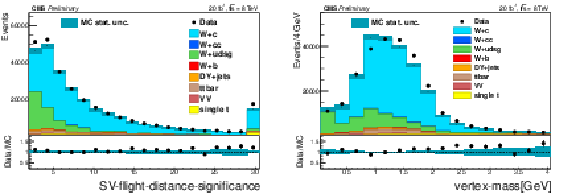
png pdf |
Figure 3:
Distributions of the flight distance significance (left) and secondary vertex mass (right) for events in the SV sample summing the contributions of the two W decay channels. The contributions from all processes are estimated with the simulated samples. Vertical bars on data points represent the statistical uncertainty in the data. The hatched areas represent the statistical uncertainty in the MC simulation. The ratio data/MC is shown at the bottom. |
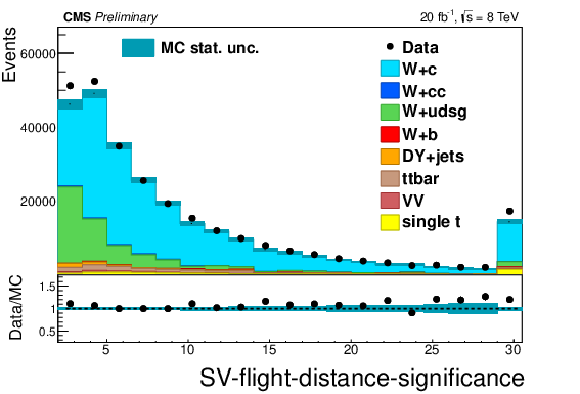
png pdf |
Figure 3-a:
Distribution of the flight distance significance for events in the SV sample summing the contributions of the two W decay channels. The contributions from all processes are estimated with the simulated samples. Vertical bars on data points represent the statistical uncertainty in the data. The hatched areas represent the statistical uncertainty in the MC simulation. The ratio data/MC is shown at the bottom. |

png pdf |
Figure 3-b:
Distribution of the secondary vertex mass for events in the SV sample summing the contributions of the two W decay channels. The contributions from all processes are estimated with the simulated samples. Vertical bars on data points represent the statistical uncertainty in the data. The hatched areas represent the statistical uncertainty in the MC simulation. The ratio data/MC is shown at the bottom. |
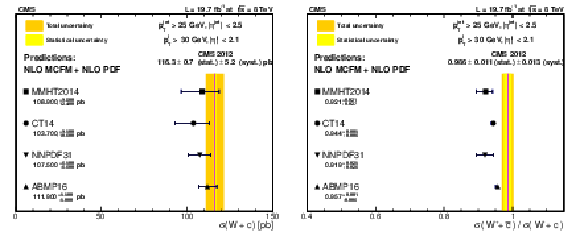
png pdf |
Figure 4:
Total cross section (left) and cross section ratio (right) data/prediction comparison. |
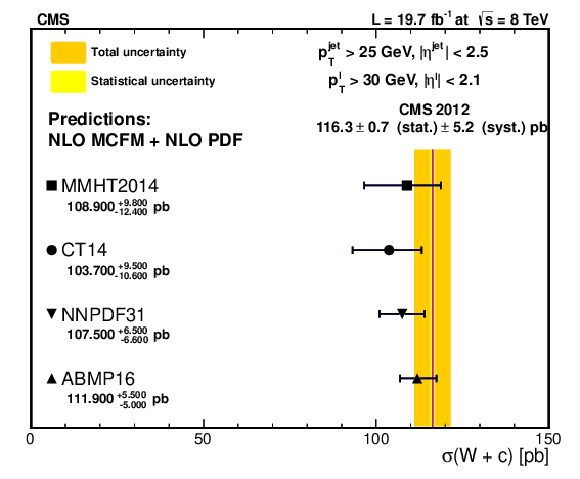
png pdf |
Figure 4-a:
Total cross section ratio data/prediction comparison. |

png pdf |
Figure 4-b:
Cross section ratio data/prediction comparison. |
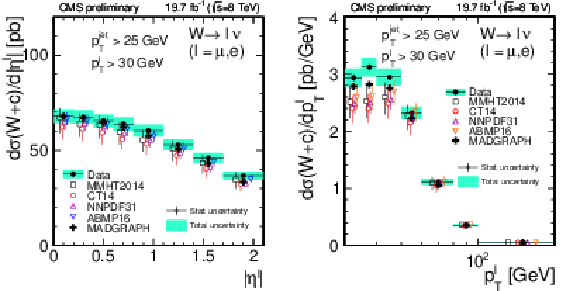
png pdf |
Figure 5:
Differential cross sections, $ {{\mathrm {d}}\sigma ({\mathrm{W} + \mathrm{c}})/ {\mathrm {d}} {| \eta |}}$ as a function of $|\eta ^\ell |$, and $ {{\mathrm {d}}\sigma ({\mathrm{W} + \mathrm{c}})/ {\mathrm {d}}{{p_{\mathrm {T}}}}}$ as a function of $ {p_{\mathrm {T}}} ^\ell $, compared with the theoretical predictions. Theoretical predictions at NLO are computed with MCFM using four different PDF sets. Kinematic selection follows the experimental requirements: $ {p_{\mathrm {T}}} ^{\rm jet} > $ 25 GeV, $|\eta ^{\rm jet}| < $ 2.5, $ {p_{\mathrm {T}}} ^\ell > $ 30 GeV, and $|\eta ^{\ell}| < $ 2.1. The data points are the average of the results with the four different samples: semileptonic and secondary vertex samples in the $ {\mathrm{W} {\rightarrow} {\mu \nu}}$ samples and $ {\mathrm{W} {\rightarrow}\mathrm{e} \nu}$ samples. Symbols showing the theoretical expectations are slightly displaced in the horizontal axis for better visibility of the predictions. The error bars in the MCFM predictions include PDF+$\alpha _{\rm s}$+ scale uncertainties. |
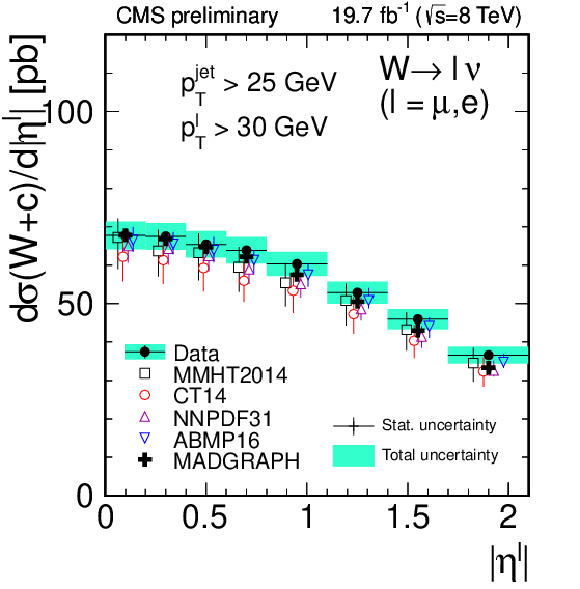
png pdf |
Figure 5-a:
Differential cross section, $ {{\mathrm {d}}\sigma ({\mathrm{W} + \mathrm{c}})/ {\mathrm {d}}{{p_{\mathrm {T}}}}}$ as a function of $ {p_{\mathrm {T}}} ^\ell $, compared with the theoretical predictions. Theoretical predictions at NLO are computed with MCFM using four different PDF sets. Kinematic selection follows the experimental requirements: $ {p_{\mathrm {T}}} ^{\rm jet} > $ 25 GeV, $|\eta ^{\rm jet}| < $ 2.5, $ {p_{\mathrm {T}}} ^\ell > $ 30 GeV, and $|\eta ^{\ell}| < $ 2.1. The data points are the average of the results with the four different samples: semileptonic and secondary vertex samples in the $ {\mathrm{W} {\rightarrow} {\mu \nu}}$ samples and $ {\mathrm{W} {\rightarrow}\mathrm{e} \nu}$ samples. Symbols showing the theoretical expectations are slightly displaced in the horizontal axis for better visibility of the predictions. The error bars in the MCFM predictions include PDF+$\alpha _{\rm s}$+ scale uncertainties. |
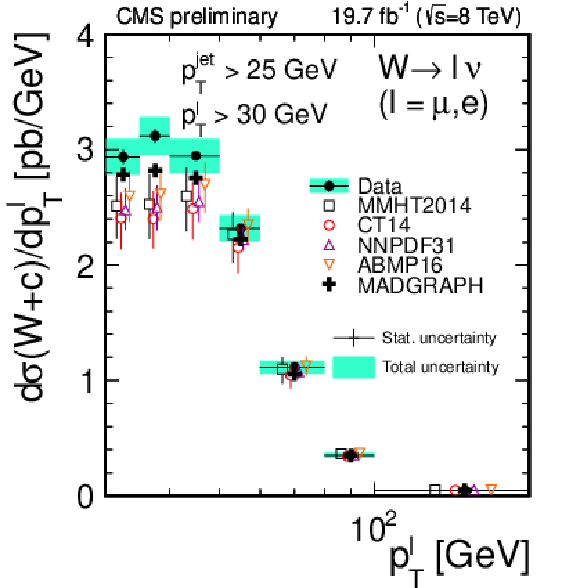
png pdf |
Figure 5-b:
Differential cross sections, $ {{\mathrm {d}}\sigma ({\mathrm{W} + \mathrm{c}})/ {\mathrm {d}} {| \eta |}}$ as a function of $|\eta ^\ell |$, and $ {{\mathrm {d}}\sigma ({\mathrm{W} + \mathrm{c}})/ {\mathrm {d}}{{p_{\mathrm {T}}}}}$ as a function of $ {p_{\mathrm {T}}} ^\ell $, compared with the theoretical predictions. Theoretical predictions at NLO are computed with MCFM using four different PDF sets. Kinematic selection follows the experimental requirements: $ {p_{\mathrm {T}}} ^{\rm jet} > $ 25 GeV, $|\eta ^{\rm jet}| < $ 2.5, $ {p_{\mathrm {T}}} ^\ell > $ 30 GeV, and $|\eta ^{\ell}| < $ 2.1. The data points are the average of the results with the four different samples: semileptonic and secondary vertex samples in the $ {\mathrm{W} {\rightarrow} {\mu \nu}}$ samples and $ {\mathrm{W} {\rightarrow}\mathrm{e} \nu}$ samples. Symbols showing the theoretical expectations are slightly displaced in the horizontal axis for better visibility of the predictions. The error bars in the MCFM predictions include PDF+$\alpha _{\rm s}$+ scale uncertainties. |
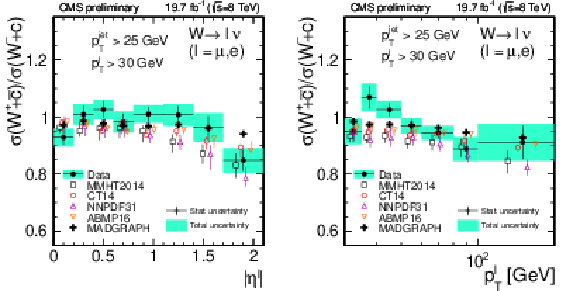
png pdf |
Figure 6:
Cross section ratio, $\sigma ({\mathrm{W^{+}} + \mathrm{\bar{c}}})/\sigma ({\mathrm{W^{-}} + \mathrm{c}})$, as a function of $|\eta ^\ell |$ and $ {p_{\mathrm {T}}} ^\ell $. The data points are the average of the results from the semileptonic and secondary vertex samples in the $ {\mathrm{W} {\rightarrow} {\mu \nu}}$ samples and $ {\mathrm{W} {\rightarrow}\mathrm{e} \nu}$ samples. Theoretical predictions at NLO computed with MCFM and four different PDF sets are also shown. Symbols showing the theoretical expectations are slightly displaced in the horizontal axis for better visibility of the predictions. The error bars in the MCFM predictions include PDF+$\alpha _{\rm s}$+ scale uncertainties. |
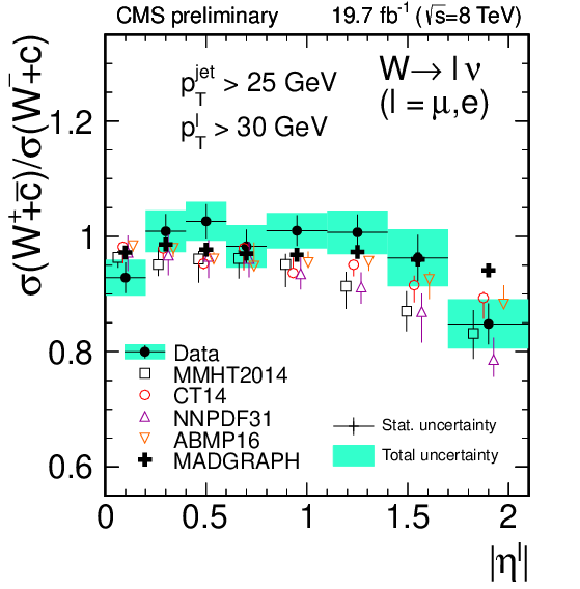
png pdf |
Figure 6-a:
Cross section ratio, $\sigma ({\mathrm{W^{+}} + \mathrm{\bar{c}}})/\sigma ({\mathrm{W^{-}} + \mathrm{c}})$, as a function of $|\eta ^\ell |$. The data points are the average of the results from the semileptonic and secondary vertex samples in the $ {\mathrm{W} {\rightarrow} {\mu \nu}}$ samples and $ {\mathrm{W} {\rightarrow}\mathrm{e} \nu}$ samples. Theoretical predictions at NLO computed with MCFM and four different PDF sets are also shown. Symbols showing the theoretical expectations are slightly displaced in the horizontal axis for better visibility of the predictions. The error bars in the MCFM predictions include PDF+$\alpha _{\rm s}$+ scale uncertainties. |
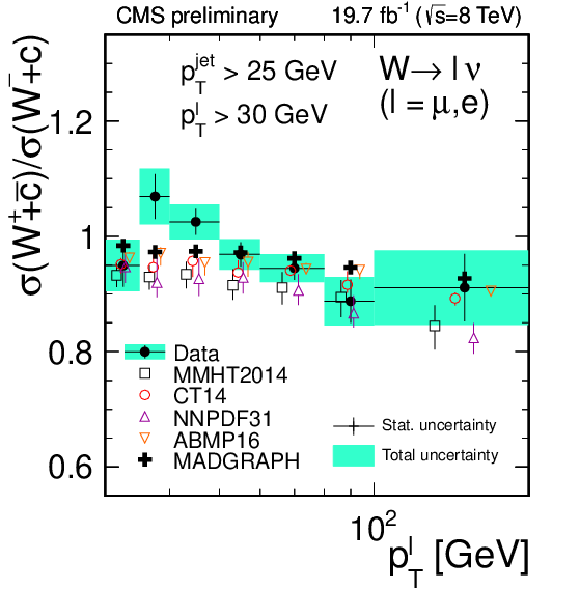
png pdf |
Figure 6-b:
Cross section ratio, $\sigma ({\mathrm{W^{+}} + \mathrm{\bar{c}}})/\sigma ({\mathrm{W^{-}} + \mathrm{c}})$, as a function of $ {p_{\mathrm {T}}} ^\ell $. The data points are the average of the results from the semileptonic and secondary vertex samples in the $ {\mathrm{W} {\rightarrow} {\mu \nu}}$ samples and $ {\mathrm{W} {\rightarrow}\mathrm{e} \nu}$ samples. Theoretical predictions at NLO computed with MCFM and four different PDF sets are also shown. Symbols showing the theoretical expectations are slightly displaced in the horizontal axis for better visibility of the predictions. The error bars in the MCFM predictions include PDF+$\alpha _{\rm s}$+ scale uncertainties. |
| Tables | |

png pdf |
Table 1:
Flavour composition after selection and OS-SS subtraction, for the electron and muon decay channels of the W boson. |

png pdf |
Table 2:
Flavour composition after selection, including OS-SS subtraction, for the electron and muon W decay channels. |
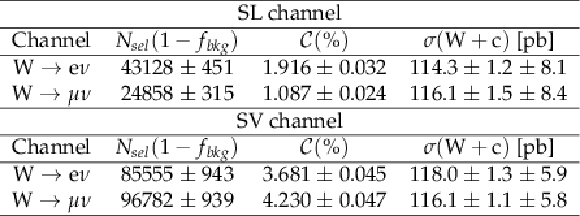
png pdf |
Table 3:
Measured production cross sections $ {\sigma ({\mathrm{W} + \mathrm{c}})}$ in the SL (top) and SV (bottom) channels for the $ {\mathrm{W} {\rightarrow}\mathrm{e} \nu}$ and $ {\mathrm{W} {\rightarrow} {\mu \nu}}$ decays separately. Statistical (first error) and systematic (second error) uncertainties are also given. |

png pdf |
Table 4:
Measured production cross sections $\sigma ({\mathrm{W^{+}} + \mathrm{\bar{c}}})$ and $\sigma ({\mathrm{W^{-}} + \mathrm{c}})$ in the SL (top) and SV (bottom) channels for the W-boson electron and muon decays separately. Statistical (first error) and systematic (second error) uncertainties are also given. |

png pdf |
Table 5:
Relative contribution on $\sigma _{W+c}$ of each systematic uncertainty for all channels. |
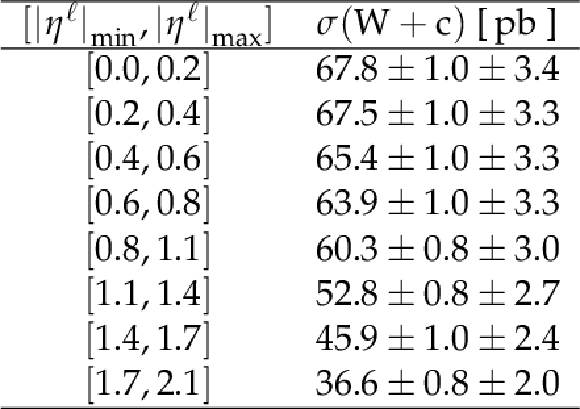
png pdf |
Table 6:
Measured differential cross section as a function of the absolute value of $|\eta ^\ell |$. Statistical (first error) and systematic (second error) uncertainties are also given. |

png pdf |
Table 7:
Measured differential cross section as a function of $ {p_{\mathrm {T}}} ^\ell $. Statistics (first error) and systematic (second error) uncertainties are also given. |
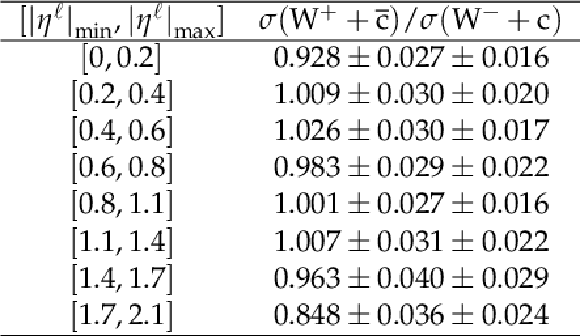
png pdf |
Table 8:
Measured ratios $\sigma ({\mathrm{W^{+}} + \mathrm{\bar{c}}})/\sigma ({\mathrm{W^{-}} + \mathrm{c}})$ as a function of the absolute value of the pseudorapidity of the lepton from the W-boson decay. Statistical (first error) and systematic (second error) uncertainties are also given. |

png pdf |
Table 9:
Measured ratios $\sigma ({\mathrm{W^{+}} + \mathrm{\bar{c}}})/\sigma ({\mathrm{W^{-}} + \mathrm{c}})$ as a function of the transverse momentum of the lepton from the W-boson decay. Statistical (first error) and systematic (second error) uncertainties are also given. |

png pdf |
Table 10:
Predictions for $ {\sigma ({\mathrm{W} + \mathrm{c}})}$ from MCFM at NLO. Kinematic selection follows the experimental requirements: $ {p_{\mathrm {T}}} ^{\ell} > $ 30 GeV, $|\eta ^{\ell}| < $ 2.1, $ {p_{\mathrm {T}}} ^{\rm jet} > $ 25 GeV, and $|\eta ^{\rm jet}| < $ 2.5. Partons are clustered into jets using an anti-$k_{\rm T}$ algorithm with a distance parameter of 0.5. For every PDF set, the central value of the prediction is given, together with the relative uncertainty as prescribed from the PDF set, and the uncertainties associated with scale variations and with the value of $\alpha _{\rm {s}}$. The last row in the table gives the experimental results presented in this document. |

png pdf |
Table 11:
Theoretical predictions for $ {R_c^{\pm}}\equiv \sigma ({\mathrm{W^{+}} + \mathrm{\bar{c}}})/\sigma ({\mathrm{W^{-}} + \mathrm{c}})$ calculated with MCFM at NLO. Kinematic selection follows the experimental requirements: $ {p_{\mathrm {T}}} ^{\ell} > $ 30 GeV, $|\eta ^{\ell}| < $ 2.1, $ {p_{\mathrm {T}}} ^{\rm jet} > $ 25 GeV, and $|\eta ^{\rm jet}| < $ 2.5. Partons are clustered into jets using an anti-$k_{\rm T}$ algorithm with a distance parameter of 0.5. For every PDF set, the central value of the prediction is given, together with the relative uncertainty as prescribed from the PDF set, and the uncertainties associated with scale variations and with the value of $\alpha _{\rm {s}}$. The last row in the table gives the experimental results presented in this document. |
| Summary |
| The associated production of a W boson with a charm quark in proton-proton collisions at a centre-of-mass energy of 8 TeV is studied with a data sample collected by the CMS experiment corresponding to an integrated luminosity of 19.7 $\pm$ 0.5 fb$^{-1}$ . The W+c process is identified by the presence of an isolated and high transverse momentum lepton (electron or muon) coming from the decay of the W boson and the reconstruction of inclusive (semileptonic and hadronic) final states from the decay of charm hadrons. Charm hadron decays are identified either by the presence of a muon inside a jet or by reconstructing a secondary decay vertex within the jet. Inclusive and differential (as a function of $\eta^\ell$ and ${p_{\mathrm{T}}}^\ell$) cross section measurements are performed with four different data samples (electron and muon W boson decay channels and reconstruction of semileptonic and hadronic decays of charm hadrons). The cross section ratio for the processes $\mathrm{W^{+}}$+c and $\mathrm{W^{-}}$+c is measured. Cross sections and cross sections ratios are found to be consistent in the four different channels and are combined. |
| References | ||||
| 1 | ATLAS Collaboration | Measurement of the production of a W boson in association with a charm quark in pp collisions at $ \sqrt{s}= $ 7 TeV with the ATLAS detector | JHEP 05 (2014) 068 | 1402.6263 |
| 2 | CMS Collaboration | Measurement of associated W+charm production in pp collisions at $ \sqrt{s} = $ 7 TeV | JHEP 02 (2014) 013 | CMS-SMP-12-002 1310.1138 |
| 3 | CMS Collaboration | Measurement of associated production of a W boson and a charm quark in proton-proton collisions at $ \sqrt{s} = $ 13 TeV | EPJC 79 (2019) 269 | CMS-SMP-17-014 1811.10021 |
| 4 | J. Alwall et al. | Madgraph 5: going beyond | JHEP 06 (2011) 128 | 1106.0522 |
| 5 | T. Sjostrand, S. Mrenna, and P. Z. Skands | PYTHIA 6.4 physics and manual | JHEP 05 (2006) 026 | hep-ph/0603175 |
| 6 | J. Alwall et al. | Comparative study of various algorithms for the merging of parton showers and matrix elements in hadronic collisions | EPJC 53 (2008) 473 | 0706.2569 |
| 7 | J. Alwall, S. de Visscher, and F. Maltoni | QCD radiation in the production of heavy colored particles at the LHC | JHEP 02 (2009) 017 | 0810.5350 |
| 8 | J. Pumplin et al. | New generation of parton distributions with uncertainties from global QCD analysis | JHEP 07 (2002) 012 | hep-ph/0201195 |
| 9 | J. M. Campbell, R. K. Ellis, P. Nason, and E. Re | Top-pair production and decay at NLO matched with parton showers | JHEP 04 (2015) 114 | 1412.1828 |
| 10 | P. Nason | A new method for combining NLO QCD with shower Monte Carlo algorithms | JHEP 11 (2004) 040 | hep-ph/0409146 |
| 11 | S. Frixione, P. Nason, and C. Oleari | Matching NLO QCD computations with parton shower simulations: the POWHEG method | JHEP 11 (2007) 070 | 0709.2092 |
| 12 | S. Alioli, P. Nason, C. Oleari, and E. Re | A general framework for implementing NLO calculations in shower Monte Carlo programs: the POWHEG BOX | JHEP 06 (2010) 043 | 1002.2581 |
| 13 | J. Gao et al. | CT10 next-to-next-to-leading order global analysis of QCD | PRD 89 (2014) 033009 | 1302.6246 |
| 14 | CMS Collaboration | Study of the underlying event at forward rapidity in pp collisions at $ \sqrt{s}=$ 0.9, 2.76, and 7 TeV | JHEP 04 (2013) 072 | CMS-FWD-11-003 1302.2394 |
| 15 | GEANT4 Collaboration | GEANT4---a simulation toolkit | NIMA 506 (2003) 250 | |
| 16 | Y. Li and F. Petriello | Combining QCD and electroweak corrections to dilepton production in the framework of the FEWZ simulation code | PRD 86 (2012) 094034 | 1208.5967 |
| 17 | A. D. Martin, W. J. Stirling, R. S. Thorne, and G. Watt | Parton distributions for the LHC | EPJC 63 (2009) 189 | 0901.0002 |
| 18 | J. M. Campbell and R. Ellis | MCFM for the Tevatron and the LHC | NPB - Proc. Suppl. 205 (2010) 10 | 1007.3492 |
| 19 | M. Czakon, P. Fiedler, and A. Mitov | Total top-quark pair-production cross-section at hadron colliders through $ {\cal O}(\alpha_{\rm S}^4) $ | PRL 110 (2013) 252004 | 1303.6254 |
| 20 | CMS Collaboration | Measurement of the inclusive W and Z production cross sections in pp collisions at $ \sqrt{s}= $ 7 TeV with the CMS experiment | JHEP 10 (2011) 132 | CMS-EWK-10-005 1107.4789 |
| 21 | CMS Collaboration | Particle-flow reconstruction and global event description with the CMS detector | JINST 12 (2017) P10003 | CMS-PRF-14-001 1706.04965 |
| 22 | M. Cacciari, G. P. Salam, and G. Soyez | The anti-$ k_t $ jet clustering algorithm | JHEP 04 (2008) 063 | 0802.1189 |
| 23 | CMS Collaboration | Determination of jet energy calibration and transverse momentum resolution in CMS | JINST 6 (2011) P11002 | CMS-JME-10-011 1107.4277 |
| 24 | CMS Collaboration | Jet energy scale and resolution in the CMS experiment in pp collisions at 8 TeV | JINST 12 (2017) P02014 | CMS-JME-13-004 1607.03663 |
| 25 | CMS Collaboration | Performance of electron reconstruction and selection with the CMS detector in proton-proton collisions at $ \sqrt{s}= $ 8 TeV | JINST 10 (2015) P06005 | CMS-EGM-13-001 1502.02701 |
| 26 | CMS Collaboration | Performance of CMS muon reconstruction in pp collision events at $ \sqrt{s}= $ 7 TeV | JINST 7 (2012) P10002 | CMS-MUO-10-004 1206.4071 |
| 27 | CMS Collaboration | MET performance in 8 TeV data | CMS-PAS-JME-12-002 | CMS-PAS-JME-12-002 |
| 28 | M. Cacciari and G. P. Salam | Pileup subtraction using jet areas | PLB 659 (2008) 119 | 0707.1378 |
| 29 | Particle Data Group Collaboration | Review of Particle Physics | CPC 40 (2016) 100001 | |
| 30 | CMS Collaboration | Identification of b-quark jets with the CMS experiment | JINST 8 (2013) P04013 | CMS-BTV-12-001 1211.4462 |
| 31 | CMS Collaboration | Measurement of $ {\mathrm b}\bar{\mathrm b} $ angular correlations based on secondary vertex reconstruction at $ \sqrt{s}= $ 7 TeV | JHEP 03 (2011) 136 | CMS-BPH-10-010 1102.3194 |
| 32 | CMS Collaboration | Measurement of the cross section and angular correlations for associated production of a Z boson with b hadrons in pp collisions at $ \sqrt{s}= $ 7 TeV | JHEP 12 (2013) 039 | CMS-EWK-11-015 1310.1349 |
| 33 | W. Waltenberger, R. Fruhwirth, and P. Vanlaer | Adaptive vertex fitting | JPG 34 (2007) N343 | |
| 34 | LHCb Collaboration | Identification of beauty and charm quark jets at LHCb | JINST 10 (2015) P06013 | 1504.07670 |
| 35 | A. Ali and F. Barreiro | The final states $ l^\pm K^\pm K^{*\pm} X $ in jets as signatures of $ {B}^{0}_{s} - \bar{B}^{0}_{s} $ mixings | Z. Phys. C 30 (1986) 635 | |
| 36 | M. Gronau, A. Nippe, and J. L. Rosner | Method for flavor tagging in neutral B meson decays | PRD 47 (1993) 1988 | hep-ph/9211311 |
| 37 | CMS Collaboration | Measurement of associated Z + charm production in proton-proton collisions at $ \sqrt{s} = $ 8 TeV | EPJC 78 (2018) 287 | |
| 38 | CMS Collaboration | Performance of b tagging at $ \sqrt{s}= $ 8 TeV in multijet, ttbar and boosted topology events | CMS-PAS-BTV-13-001 | CMS-PAS-BTV-13-001 |
| 39 | M. Lisovyi, A. Verbytskyi, and O. Zenaiev | Combined analysis of charm-quark fragmentation-fraction measurements | EPJC 76 (2016) 397 | 1509.01061 |
| 40 | ALEPH Collaboration | A measurement of the gluon splitting rate into $ {\rm c\bar c} $ pairs in hadronic Z decays | PLB 561 (2003) 213 | hep-ex/0302003 |
| 41 | ALEPH Collaboration | A measurement of the gluon splitting rate into $ {\rm b} \bar {\rm b} $ pairs in hadronic Z decays | PLB 434 (1998) 437 | |
| 42 | CMS Collaboration | CMS Luminosity Based on Pixel Cluster Counting - Summer 2013 Update | CMS-PAS-LUM-13-001 | CMS-PAS-LUM-13-001 |
| 43 | J. M. Campbell and F. Tramontano | Next-to-leading order corrections to Wt production and decay | NPB 726 (2005) 109 | hep-ph/0506289 |
| 44 | L. A. Harland-Lang, A. D. Martin, P. Motylinski, and R. S. Thorne | Parton distributions in the LHC era: MMHT 2014 PDFs | EPJC 75 (2015) 204 | 1412.3989 |
| 45 | S. Dulat et al. | New parton distribution functions from a global analysis of quantum chromodynamics | PRD 93 (2016) 033006 | 1506.07443 |
| 46 | NNPDF Collaboration | Parton distributions from high-precision collider data | EPJC 77 (2017) 663 | 1706.00428 |
| 47 | S. Alekhin, J. Blumlein, and S. Moch | NLO PDFs from the ABMP16 fit | EPJC 78 (2018) 477 | 1803.07537 |

|
Compact Muon Solenoid LHC, CERN |

|

|

|

|

|

|